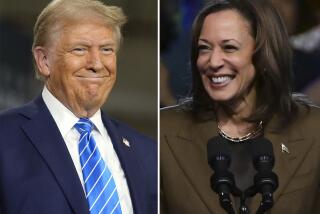Fiscal Problems Mean No Cakewalk for New Governors
- Share via
Nearly half the states will start the new year with a new governor, but the freshmen -- and reelected incumbents too -- are taking control at a time when their states are facing the most dire financial prospects in half a century.
At least 23 new governors -- possibly 24, depending on final results in Alabama -- won election this year, the most since the National Governors Assn. began tracking in 1982.
Though term limits forced out many incumbents, voters were clearly in a mood for change. Parties in power were ousted in 16 of the 20 races for open seats.
Now, the men and women elected have to act, and the options promise to be painful.
“It’s the worst fiscal situation since the Second World War,” said Ray Scheppach, executive director of the NGA.
Stopgap measures taken over the last two years sharply limit choices before the new governors, he said.
“They’ve done the easy and even the moderately difficult cuts,” along with fee increases and taxes on cigarettes, Scheppach said. “From here on, you’re going to be cutting into real programs that are going to have effects on people.”
Voters chose new faces in nearly two of every three races Tuesday.
Term limits forced 14 governors out of office, while six chose not to run. Voters ousted three incumbents, and possibly a fourth -- Alabama Gov. Donald Siegelman has been fighting to reverse what appears to be a narrow loss. His request for a recount was rejected Friday.
Many of the candidates campaigned on promises that they could guide their states through a minefield of weakening revenues and rising health-care costs without raising taxes.
Before the election, others attempted to minimize the pain, or at least the perception of fiscal problems.
Ohio Gov. Robert A. Taft before the election refused to discuss potential deficits, despite his opponent’s accusation that the state would be short $4 billion in 2003.
Two days after winning reelection, Taft, a Republican, acknowledged a future problem. “There will be a deficit,” he said. He said it was too early to estimate how big.
In South Carolina, Democratic Gov. Jim Hodges refused to cut budgets after an economic advisory board predicted a shortfall. He was defeated.
Hawaii Gov.-elect Linda Lingle, the state’s first female governor and its first GOP chief in 40 years, called for a wholesale audit of state government. “I could walk in today and find millions of dollars right off the top without ever getting into a program or the delivery of service to the public,” she said.
But the economic prospects are far from bright. Last year saw about $50 billion in shortfalls to state budgets, and the latest estimates project $57 billion more in the current year, Scheppach said.
With the national economy sputtering and anecdotal reports that many states are already seeing a return of last year’s severe revenue weakness, good financial news seems far off for state planners.
In the weeks before the elections, most pollsters and analysts said there was a clear link between the weak performance of incumbents and the budget problems worrying the states.
“The budget swamp is a treacherous place for state politicians to be wading around in,” said Ron Faucheux, editor of Campaigns & Elections, a magazine for politicians. “In gubernatorial politics, when times are tough economically and revenues are falling, that’s where they are -- the budget swamp.”
Still, governors-elect are flush with ideas.
Many new and sitting governors will gather in private with the NGA next weekend in Austin, Texas, to discuss problems and consider potential solutions.
More to Read
Get the L.A. Times Politics newsletter
Deeply reported insights into legislation, politics and policy from Sacramento, Washington and beyond. In your inbox twice per week.
You may occasionally receive promotional content from the Los Angeles Times.









